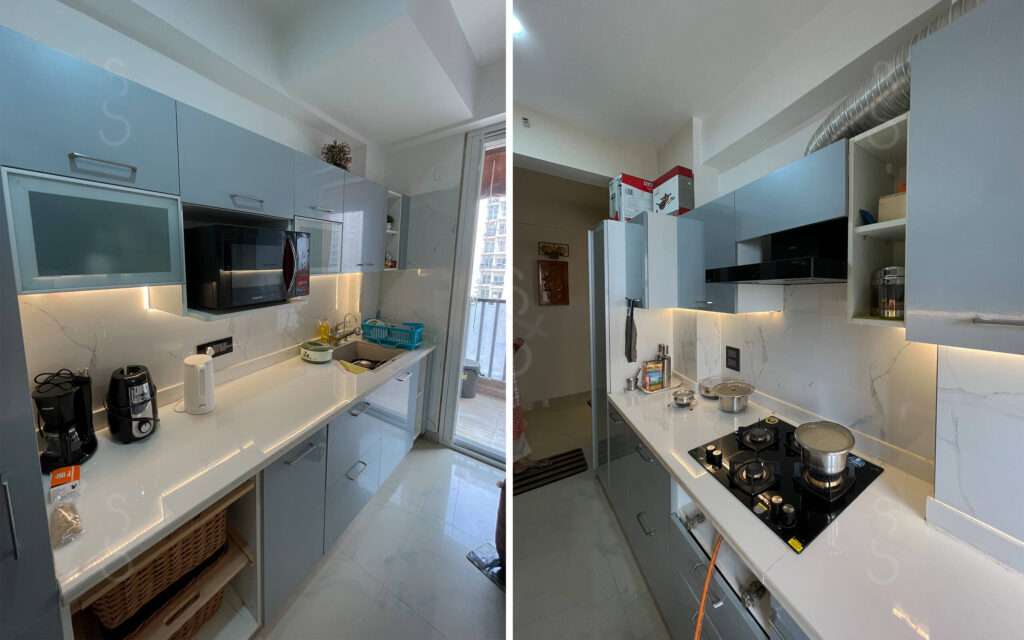
The kitchen is the heart of every home, but for Indian households, it holds a special place. Indian cooking is rich, diverse, and often requires several steps, ingredients, and specialized tools. Therefore, designing a functional kitchen that meets the unique demands of Indian cooking is essential. A well-thought-out kitchen design can make cooking easier, more enjoyable, and more efficient.
In this blog, we’ll discuss how to create a kitchen that is not only aesthetically pleasing but also highly functional for the intricacies of Indian cooking.
1. Prioritize Storage Space
Indian cooking typically involves a wide range of spices, grains, lentils, and various other ingredients that need to be easily accessible. Storage plays a crucial role in ensuring your kitchen remains organized.
- Spice Storage: Spices are a cornerstone of Indian cuisine, and having a dedicated space for them is key. Consider installing pull-out spice racks or deep drawers with dividers for easy access to your spice jars. You can also opt for a traditional “masala dabba” (spice box), which provides convenient storage for frequently used spices.
- Pantry and Shelf Storage: A spacious pantry or cabinets with adjustable shelves can house all the bulk ingredients like rice, pulses, flours, and oils. Ensure that the pantry is easily accessible and well-organized, with clear labeling for quick identification.
- Deep Cabinets and Drawers: Use deep cabinets and drawers for storing large pots, cooking utensils, and cookware. Opt for pull-out or pull-down shelves to maximize vertical storage space.
- Dedicated Storage for Appliances: Indian cooking often requires specialized appliances like a pressure cooker, dosa tawa, and multiple grinding tools. Design storage solutions that keep these appliances hidden yet easily accessible.
Tip: Modular storage solutions with pull-out trays or pull-down shelves are perfect for storing heavy and bulky items.
2. Maximize Counter Space for Preparation
Indian cooking involves lots of prep work—from chopping vegetables to grinding spices. Therefore, counter space is essential for a smooth cooking process.
- Large Work Surfaces: Incorporate a spacious countertop where you can comfortably perform all tasks, from kneading dough to making masala pastes. Granite, marble, or quartz countertops are durable, easy to clean, and can handle heavy-duty tasks.
- Separate Areas for Cooking and Prep: If you have the space, try to create separate work zones—one for prepping ingredients and another for cooking. This helps maintain an organized flow and minimizes the need to clean up between stages.
- Under-Cabinet Counter Extensions: If counter space is limited, consider under-cabinet pull-out extensions or foldable countertops that can be expanded when needed for additional prep space.
Tip: Keep frequently used ingredients, such as onions, garlic, and ginger, near the prep station to save time.
3. Consider the Workflow: The Kitchen Triangle
The kitchen triangle concept (the layout between the stove, sink, and refrigerator) is an essential factor to consider in designing a functional kitchen. For Indian cooking, this triangle ensures that food prep, cooking, and cleaning are efficient.
- Sink and Cooking Area: Place the sink close to the cooking area to make it easy to rinse vegetables or clean utensils without crossing the entire kitchen.
- Stove Position: Ensure that the stove is in a position that allows you to easily reach for ingredients from your pantry and prep area. Consider a multi-burner cooktop for cooking multiple dishes simultaneously, a common need in Indian kitchens.
- Refrigerator Location: The fridge should be easily accessible to store fresh produce and ingredients that require cooling. Place it near the prep station so that you can quickly grab items for cooking.
Tip: Make sure there is enough space between the stove, sink, and fridge to allow for easy movement and avoid congestion in the kitchen.
4. Invest in High-Quality, Durable Appliances
Indian cooking often requires a variety of kitchen appliances that work efficiently under frequent use. Investing in durable, high-quality appliances is essential to save time and effort in the long run.
- Gas or Induction Cooktop: Indian cooking typically requires multiple burners for preparing different dishes simultaneously. A high-efficiency gas stove or an induction cooktop with sufficient burners is a must-have. Induction cooktops offer precision control, while gas stoves offer versatility.
- Mixer-Grinder or Wet Grinder: A powerful mixer-grinder is an indispensable tool for grinding spices, pastes, and chutneys. For more traditional dishes, you may also want to consider a wet grinder for grinding rice and lentils for dosa or idli batter.
- Pressure Cooker: The pressure cooker is a staple in Indian kitchens. Opt for a good-quality stainless steel or aluminum pressure cooker that offers multiple sizes for cooking rice, lentils, and stews.
- Microwave and Oven: A microwave is perfect for reheating leftovers or defrosting frozen food. A convection oven is ideal for baking, grilling, or roasting. These appliances add versatility to your cooking process.
- Dishwasher: A dishwasher can save time in cleaning large volumes of dishes after cooking meals for family gatherings or festive occasions.
Tip: Choose appliances with energy-saving features to reduce utility costs and improve kitchen efficiency.
5. Ensure Proper Ventilation
Cooking aromatic Indian dishes like curries, deep-fried snacks, and tandoori can result in strong odors and smoke. Proper ventilation is essential to maintain a fresh and comfortable cooking environment.
- Range Hood: Install a high-quality chimney or range hood over your cooktop to effectively remove smoke, fumes, and cooking odors. Choose one with high suction power to ensure efficient air circulation.
- Windows and Ventilation: Ensure there are windows or ventilation openings to allow fresh air to circulate, especially when you’re cooking aromatic spices.
- Air Purifiers: If you live in an area with poor outdoor air quality, consider installing an air purifier to maintain a healthy kitchen environment.
Tip: A kitchen exhaust fan with different speed settings helps in removing stubborn cooking odors and smoke, especially during heavy-duty cooking sessions.
6. Use Multi-Functional Fixtures
In a kitchen where space is often at a premium, every inch counts. Use multi-functional fixtures that help you save space while increasing utility.
- Pull-Out Faucets: A pull-out faucet can help with washing large pots and pans, especially when cleaning after making traditional dishes that require heavy utensils.
- Pull-Out Shelves and Drawers: Instead of bulky cabinets, use pull-out shelves or drawers to store cookware, utensils, and cleaning supplies. They provide easy access to items at the back of your cabinets, reducing clutter and improving organization.
- Smart Kitchens: Consider investing in smart kitchen solutions like touchless faucets, voice-controlled lights, or smart ovens that can be controlled from your phone for added convenience.
Tip: Incorporate an under-sink storage unit to store cleaning supplies, garbage bags, or extra utensils, keeping your kitchen free from unnecessary clutter.



